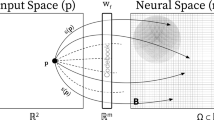Abstract.
The self-organizing map (SOM), a widely used algorithm for the unsupervised learning of neural maps, can be formulated in a low-dimensional ‘feature map’ variant which requires prespecified parameters (‘features’) for the description of receptive fields, or in a more general high-dimensional variant which allows self-organization of the structure of individual receptive fields as well as their arrangement in a map. We present here a new analytical method for deriving conditions for the emergence of structure in SOMs which is particularly suited for the as yet inaccessible high-dimensional SOM variant. Our approach is based on an evaluation of a map distortion function. It involves only an ansatz for the way stimuli are distributed among map neurons; the receptive fields of the map need not be known explicitly. Using this method we first calculate regions of stability for four possible states of SOMs projecting from a rectangular input space to a ring of neurons. We then analyze the transition from nonoriented to oriented receptive fields in a SOM-based model for the development of orientation maps. In both cases, the analytical results are well corroborated by the results of computer simulations.
Similar content being viewed by others
Author information
Authors and Affiliations
Additional information
Received: 18 December 1995 / Accepted in revised form: 24 July 1996
Rights and permissions
About this article
Cite this article
Riesenhuber, M., Bauer, HU. & Geisel, T. Analyzing phase transitions in high-dimensional self-organizing maps . Biol Cybern 75, 397–407 (1996). https://doi.org/10.1007/s004220050305
Issue Date:
DOI: https://doi.org/10.1007/s004220050305




